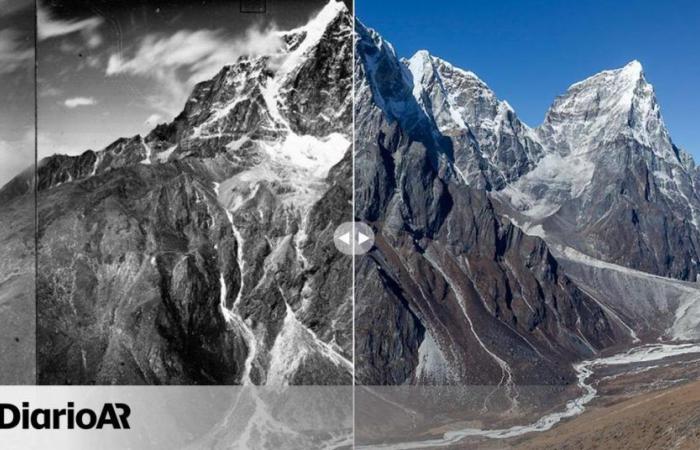
“Deep in my heart, when I see this landscape I believe there is a problem and people should know about it.” The American climber David Breashears expressed with these words what he felt when photographing in 2007 the same Himalayan valley that the pioneer George Mallory had portrayed in 1924 and comparing both images. Almost a century later, Everest still dominates the scene in the background, but the Rongbuk glacier has thinned noticeably and what was once a river of ice is now a bed of rocks.
This is one of the comparative images that the promoters of the #SaveOurSnow campaign (Let’s save our snow) are using to try to raise awareness in the world about the impact that climate change is having in the Himalayas and the consequences it will have for the population of especially populated areas of this region, such as the Hindu Kush. In these snapshots, and other more updated ones that elDiario.es has accessed, you can see the changes experienced in the region around Everest since the middle of the 20th century, with an enormous retreat of the ice in each of the places.
“What we see in the photographs is a very tangible example of how climate change is affecting the environment,” explains Miriam Jackson, cryosphere expert at the International Center for Integrated Mountain Development (ICIMOD) and one of the coordinators of the bell. “Glaciers are like a sensor of phenomena that are invisible, such as the increase in temperature and CO2. Here the images are telling you: look, this is real, it is happening and it is going faster and faster.”
“An SOS from the roof of the world”
The Himalayan valleys where snow and ice are retreating ever faster are the best place on the planet to understand what is happening, in Jackson’s opinion. “Climate change is the crime scene and the glaciers are making it visible,” he comments in a video conference from Kathmandu. That is why this initiative aims to bring together mountain communities, climbers, athletes and scientists to launch “an SOS from the roof of the world.”
The report on the impact of warming in the Himalayas launched by ICIMOD in 2023 (the so-called Hi-Wise) already warned that, if we maintain the rate of greenhouse gas emissions, 80% of the current volume of the glaciers of This area of the planet will have disappeared by 2100 and floods and landslides will multiply. “In this region, hundreds of millions of people depend largely on glacial water and are very vulnerable to changes, because they affect agriculture and can alter basic subsistence levels,” warns Jackson.
What the reports indicate is an acceleration in the rate of melting in the last decade. “Now it is receding at a rate of half a meter per year,” says the expert. When you look at the data tables for the entire Himalayas, you can clearly see that, as we get closer to the present, the rate of melting increases, especially in the eastern zone, where more people live and the effects of the weather are more noticeable. changes in monsoon cycles due to the climate crisis. “It’s like seeing the effects of rising temperatures evolving over time,” she says.
Witnesses of the destruction
The most revealing photographs of the valleys near Everest have been taken by geographer and mountaineer Alton Byers, who has been repeating photos taken by pioneer climbers for years to show the spectacular changes taking place in this region. “In the course of their explorations, pioneers like the Austrian climber Erwin Schneider took hundreds of photographs, so I returned to these places and repeated the photos from the exact points,” Buyers explains to elDiario.es. “And what I saw shocked me.”
The images are telling you: look, this is real, it is happening and it is going faster and faster
In his continuous visits to the Himalayas, Buyers has seen tremendous changes, glaciers that suddenly become immense lakes that grow every year due to melting ice and threaten the population, floods that suddenly emanate from the glacier and wash away everything, the permafrost that melts even at high altitudes or rock falls and landslides that change the landscape.
“The repeated photograph It offers you a window to the past, but you have to understand that it is only a moment in time and between each other things happen that we can now see by satellite,” Buyers summarizes. “But it turns out to be a medium that speaks very clearly to people, because you put yourself in the place and time: people understand that something is happening, that something is not going well.”
Anyone who has continuously visited the Himalayas in recent decades has noticed the changes. “We climbers are privileged witnesses, because we have not only seen the ice; We have stepped on them, we have climbed them and we have seen in real time what was happening, we did not need anyone to tell us,” says Spanish climber and adventurer Sebastián Álvaro. “I have been in the Himalayas in the 80s and now, forty years later, the impact is seen in all the glaciers”
I have been in the Himalayas in the 80s and now, forty years later, the impact is seen in all the glaciers
The veteran explorer has recently been to Antarctica and is concerned because the thaw is already visible there with the naked eye. “There is blatant glacial retreat across the planet.” Sebastián Álvaro points out that the places where melting is advancing at the fastest rate are Patagonia, Greenland and certain glaciers in the Himalayas, with the particularity that there the human impact can be much greater. “Thousands of people live off the water from the mountain glaciers,” he says. “Not only will there be a lack of water, but the glaciers create lakes and when they burst they affect the populations that live below, with great loss of human beings and crops.”
Campaigns like this, believes Eñaut Izagirre, glaciologist and professor at the University of the Basque Country (UPV/EHU), are especially timely and prepare the ground for 2025, which the UN has decided to designate as an international year for glacier conservation. “The volume of ice in this area of the planet, the high Asian mountains, is such that historically it has been considered the “third pole” and is considered one of the water towers (the water towers),” he explains.
The waters that merge in these mountains feed four large rivers and provide drinking for almost a quarter of the world’s population, about 2 billion people.
“The waters that merge in these mountains feed four great rivers, the Ganges, the Brahmaputra, the Indus and the Yellow River, and it is often said that they provide drinking water for almost a quarter of the world’s population, about 2 billion people. ”. That is why it is important to raise awareness of this global problem, he points out, and even more so taking into account that in some places such as the Pyrenees and the Alps the rate of melting has tripled in the last two years.
“To be honest, this acceleration has impressed even us scientists, because we didn’t think things were going to change so quickly,” confesses Miriam Jackson. For her, what is also worrying is that all of this is happening at the same time around the world and increasingly faster. When it comes to the future, the models are not exactly optimistic. If we continue at this pace, she says, in a few years we will have an average rate of retreat of the Himalayan glaciers of up to one meter per year. “These changes are already affecting hundreds of millions of people and will affect the rest of us in many different ways,” she concludes. “We can’t look the other way.”





